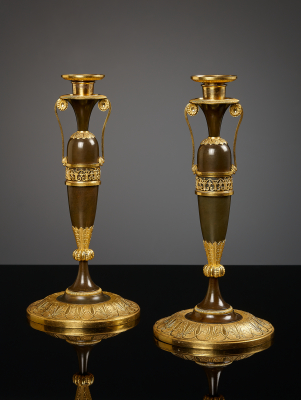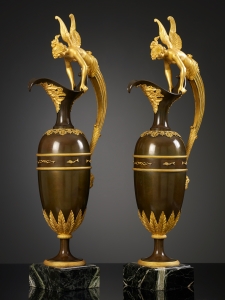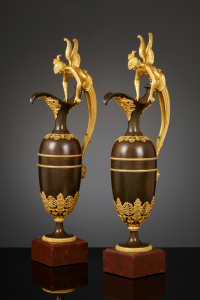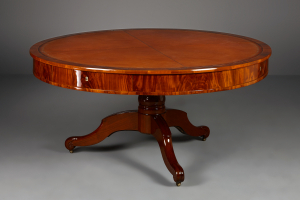Pair of French Directoire candlesticks, attributed to Claude Galle
Pair of French Directoire candlesticks, attributed to Claude Galle
A pair of particularly elegant candlesticks in gilt and patinated bronze. The patinated bronze bases of the candlesticks derive their shape from a small Roman amphora, and are set in gilt bronze mounts. Halfway up each vase’s body is a broad openwork band, above which the gilt bronze handles, in further mimicry of an amphora, extend towards the flaring upper rim ringed with a gilt bronze edge. The bottom of each vase tapers to a point in a gilt bronze collar in the shape of erect acanthus leaves that form a knot at the bottom. Below this, the vase segues into a slender foot that stands upon a slightly concave, gilt bronze base with elegant relief patterns. The candlesticks are each crowned with a gilt bronze candleholder.
The striking visual idiom and style are typical of the works of the French bronzier Claude Galle.
The prominent bronze caster Claude Galle was born in Villepreux, near Versailles, and later moved to Paris to apprentice under Pierre Foy. In 1784 Galle married Foy’s daughter, taking over his father-in-law’s business upon his death in 1788. Under Galle’s leadership, the workshop grew into the most prestigious of its kind in France, employing some 400 workers. Galle first moved the business to Quai de la Monnaie (later known as Quai de l’Unité), then relocated to 60 Rue Vivienne in 1805. Galle’s name is recorded in the trade registers from 1784 on. He reached the rank of master bronze caster in 1786, and almost immediately received his first commission from the Garde-Meuble de la Couronne, which was managed by Jean Hauré from 1786 to 1788.
We know that Galle collaborated with Pierre-Philippe Thomire, among other people, and provided the lion’s share of the bronzes for the furniture of the Palace of Fontainebleau during the Empire period. Aside from furniture ornamentation, he also supplied many vases, ornamental ewers, lighting fixtures, cases for pendules aux sujets and other bronze ornaments for the palaces of Saint-Cloud, Triannon, Tuileries, Compiegne, and Rambouillet, as well as various Italian palazzos, including Monte Cavallo in Rome and Stupinigi near Turin.
Although Galle had no lack of commissions, he regularly found himself in financial difficulties. This was partly the result of his lavish lifestyle, but also because many clients (such as Prince Joseph Napoleon) flatly refused to pay him. After Galle’s death, the business was reopened and successfully carried on by his son, Gérard-Jean Galle (1788-1846). Like his father, Gérard-Jean’s works are found in the world’s most prestigious collections, such as the Musée National de Château de Malmaison, Musée Marmottan in Paris, Museo de Relojes in Jerez de la Frontera, the Residenz in Munich and the Victoria & Albert Museum in London.
- Period
- ca. 1800
- Material
- fire-gilt and patinated bronze
- Dimensions
- 28 cm
Global shipping available







